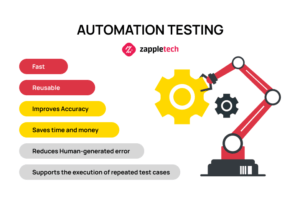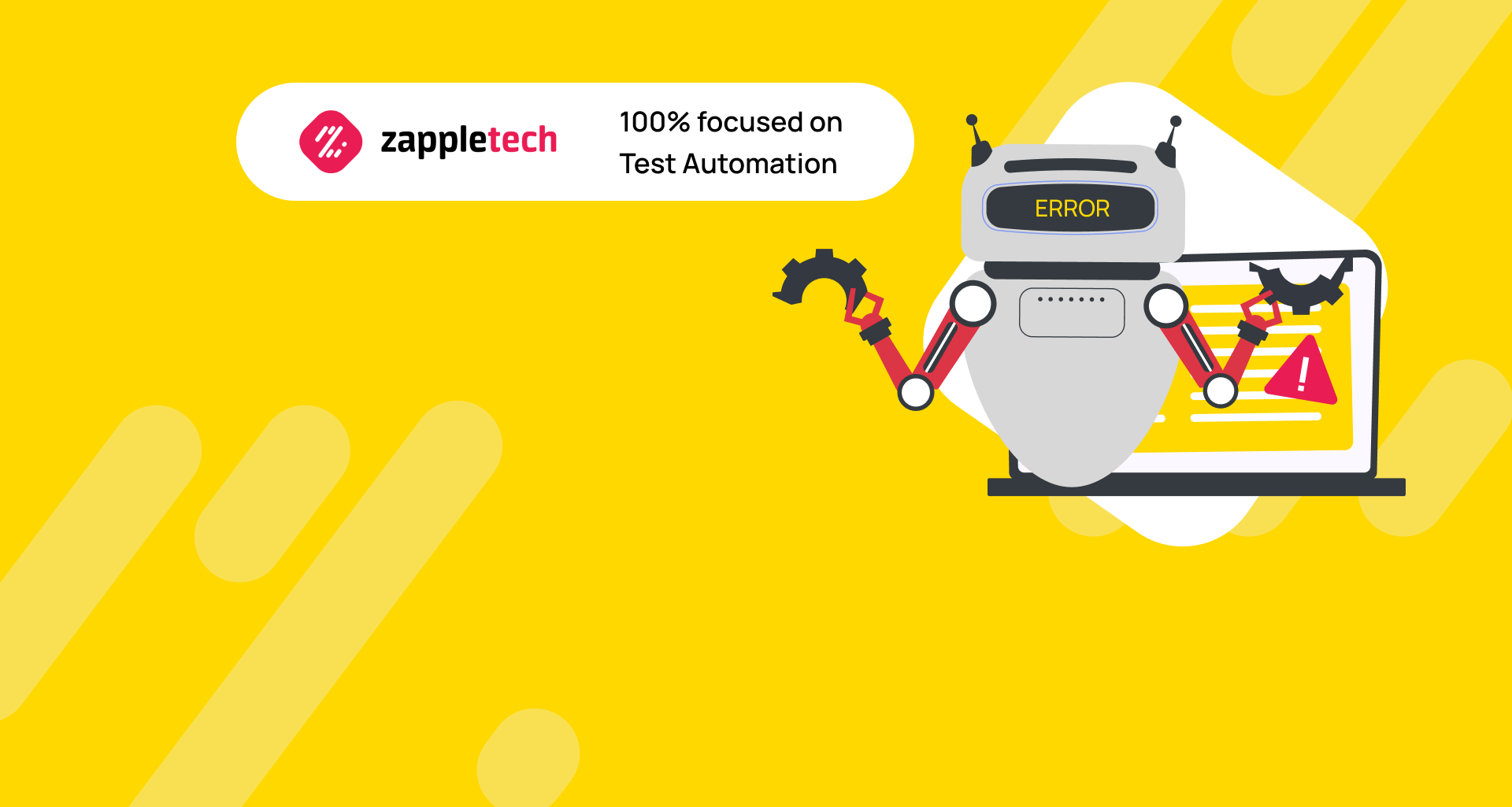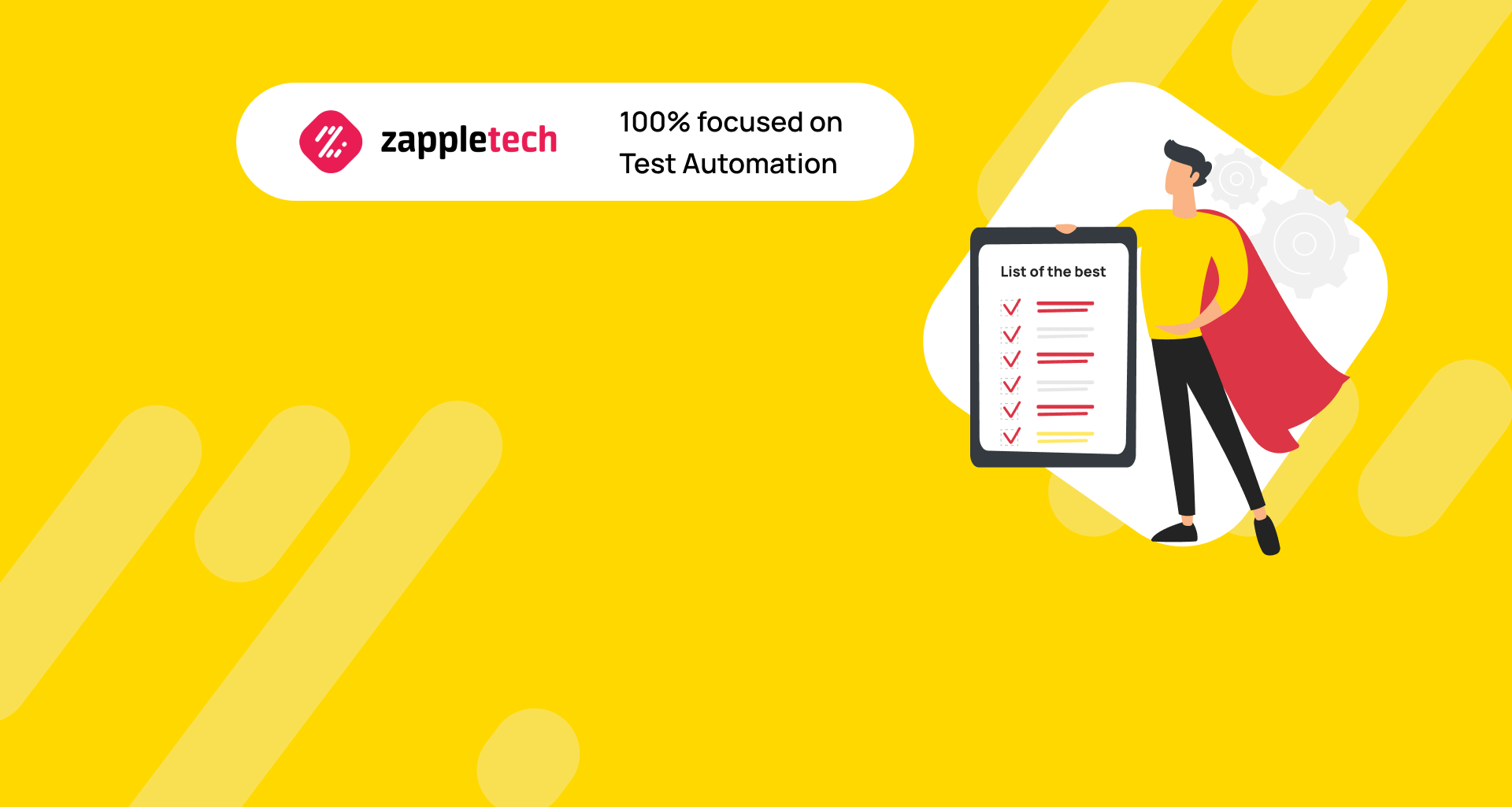Hello dear readers! As you already know from our past articles, automating tests is a challenging but interesting job that only experienced QA experts can do. The journey of automation testing is full of rewards, but it is not without its hurdles. Despite the challenges in automation testing, the market share for this technology is growing at an impressive average annual rate of 16%. According to Gminsights, the automation market was valued at $15 billion at the end of 2020, which is a substantial figure in the IT industry.
On one hand, automation testing significantly speeds up the development process by ensuring faster and more reliable testing cycles. However, it also introduces automation testing challenges that can sometimes hinder progress. These challenges range from the initial setup of automation frameworks to maintaining the test scripts over time, especially as applications evolve.
Experts from ZappleTech have delved deep into the topic of testing and have identified several common difficulties that QA teams face. In this article, we’ll explore the challenges faced in automation testing in general and provide insights into the methods for overcoming them. Understanding these challenges is crucial for anyone looking to implement or improve their automation testing strategy.
Sit back, we’re getting started!
Table of Contents
Automation: Common Difficulties and Problems

First, let’s delve deeply into the main challenges in automation testing that nearly all QA specialists encounter. Automation testing, while a powerful tool for ensuring software quality, comes with its own set of complexities. Understanding these automation testing challenges is crucial for anyone involved in software development and quality assurance.
Technical Complexities in Automation Testing
One of the primary challenges in automation testing lies in the technical side of the process. Developing and maintaining test scripts can be daunting, especially as applications evolve over time. Test automation requires a deep understanding of programming languages, testing frameworks, and the application under test. The automation scripts must be robust and adaptable to changes in the application, which often requires significant effort and expertise. This complexity can lead to increased costs and longer development times, which are critical factors for any organization.
Purpose and Effectiveness of Testing
Another significant challenge in automation testing is ensuring that the testing serves its intended purpose. While automation can speed up the testing process and increase coverage, it’s not always straightforward to determine if the tests are genuinely effective. Automation testing challenges often include ensuring that the tests are correctly identifying defects and not merely executing without adding real value. This involves creating well-designed test cases that cover critical scenarios and continuously refining them based on feedback and results.
Decryption and Analysis of Reporting
The reporting aspect of automation testing is another area that presents significant challenges. Decrypting the results and understanding the data generated by automated tests can be complex, particularly when dealing with large volumes of information. Automation testing tools often generate detailed reports, but interpreting these reports to gain actionable insights requires both time and expertise. QA specialists must be able to identify false positives, understand the root cause of failures, and make informed decisions based on the test results.
Regularly update and refactor your test scripts to avoid failures due to changes in the application. This helps in reducing one of the most common automation testing challenges—outdated test cases.Mykhailo PoliarushCEO, ZappleTech Inc.
Integration with Continuous Integration/Continuous Deployment (CI/CD) Pipelines
Integrating automation testing into CI/CD pipelines is another challenge that QA teams frequently face. Automation testing must be seamlessly integrated into the development workflow to ensure that tests are run automatically whenever changes are made to the codebase. This integration can be technically challenging, requiring careful coordination between development and QA teams. Additionally, maintaining the reliability and speed of these tests in a fast-paced CI/CD environment is critical, as slow or unreliable tests can bottleneck the entire development process.
Dealing with Flaky Tests
Flaky tests, or tests that sometimes pass and sometimes fail without any changes to the code, represent one of the more frustrating challenges in automation testing. These inconsistencies can lead to wasted time and effort as teams try to identify the root cause of the issue. Flaky tests can undermine the confidence in the automation suite, leading teams to question the validity of their test results. Addressing flaky tests requires a combination of robust test design, proper environment setup, and continuous monitoring.
Tool Selection and Maintenance
Selecting the right tools for automation testing is another significant challenge. With the vast array of tools available, each with its own strengths and weaknesses, choosing the one that best fits the project’s needs can be overwhelming. Moreover, once a tool is selected, it must be maintained and updated regularly to keep up with changes in the application and industry standards. Automation testing challenges in this area also include ensuring that the chosen tools are compatible with other systems and technologies used in the project.
Scalability of Test Automation
Scalability is a crucial consideration, especially as projects grow in size and complexity. Automation testing must scale to handle an increasing number of test cases and larger datasets without compromising performance. This scalability challenge involves optimizing test scripts, managing resources efficiently, and ensuring that the testing framework can handle the load. Failure to address scalability can lead to delays and reduced test coverage, which in turn affects the quality of the software.
Balancing Automation with Manual Testing
Finally, one of the ongoing challenges in automation testing is finding the right balance between automated and manual testing. While automation is powerful, it cannot replace the human intuition and exploratory nature of manual testing. Certain scenarios, particularly those involving complex user interactions or visual checks, are better suited for manual testing. QA teams must carefully decide which tests to automate and which to perform manually to ensure comprehensive coverage and effective testing outcomes.
4 problem areas in SQA automation
When dealing with automation testing across various platforms and technical stacks, it’s crucial to recognize the distinct nuances and challenges in automation testing that may arise. While the methods of testing might be similar across different environments, each platform presents unique obstacles that require careful consideration.
For instance, one of the primary automation testing challenges is ensuring compatibility across multiple platforms, such as mobile, web, and desktop applications. Each platform may have its own set of requirements, frameworks, and tools that need to be addressed during the testing process. Additionally, the technical stack used in development, whether it’s a specific programming language or framework, can introduce its own set of complexities.
In this section, we’ll explore both the difficulties and the more benign nuances that can influence Software Quality Assurance (SQA). These factors, although sometimes minor, can collectively impact the overall efficiency and effectiveness of automation testing. By understanding and addressing these challenges in automation testing, teams can better prepare for potential pitfalls and optimize their testing strategies for better results.
Automation testing coding challenges
Technical difficulties of automation:
- Knowledge of coding by specialists. Syntax similar to TypeScript is used to write scripts.
- Ability to prepare suitable cases. Here, not only the script is important, but also its detailed description.
- Analysis and interpretation of the results. Each tool generates reports in different formats, so processing takes time.
- The language barrier. Complex testing requires knowledge of at least a few popular programming languages.
- Variability. If urgent adjustments are made during the sprint, most ready-made cases lose their relevance.
The essential characteristic of QA specialists is their background. The more varied the experience of experts, the more confidently they solve the difficulties arising on the way to perfection.
Challenges in automation in software testing

Let’s focus on two common archetypes of programs: web and desktop solutions. Checks involve similar methodology but differ in tools and scripts tied to specific syntaxes.
Difficulties in automating desktop app tests:
- Test bench. In parallelization, virtual machines may overload the working hardware.
- Time. Even with full-fledged parallel testing, the average interface test time reaches a couple of hours.
- Tools. To work with most computer programs, specific products are needed, most often paid and complex.
- Skills. Without a QA background, it is difficult for a QA professional to use native tools like Appium or Selenium.
In fact, desktop programs are fading into the background, so they are not a priority when training new specialists.
Difficulties in automating web app tests:
- Variety. There are many tools for testing cloud products, so it can be difficult to choose the best one.
- Multiplatform. Typically, these IT solutions run on multiple operating systems, making full testing complicated.
- Cloud. Quite expensive for QA newbies, but it simplifies checking a product across all platforms.
- Credibility. Most tools provide reports in hard-to-read logs, which are often ignored by experts.
Now it’s not a problem to find a universal tool, get acquainted with the basic guides, and start testing, but its quality will be below average.
Challenges in framework automation
Frameworks are vital components of modern cloud solutions, especially in the development of mobile products. However, the complexity of these frameworks presents several challenges in automation testing. Ensuring that the testing tools and processes can effectively handle the dynamic and multifaceted nature of these frameworks is crucial.
When it comes to automation testing challenges, one of the most significant is the integration and compatibility with various cloud-based environments. The same tools that are employed for testing cloud solutions must be adept at addressing the unique aspects of mobile product frameworks. This involves not only adapting to different platforms and devices but also ensuring that the automation processes are robust enough to handle the rapid iterations and updates typical of mobile development.
For those looking to delve deeper into the tools and techniques used to overcome these automation testing challenges, we recommend exploring our previous materials, which provide valuable insights into optimizing automation for cloud solutions.
Choose automation tools that align with your project’s specific needs. The wrong tool can introduce more challenges in automation testing, such as compatibility issues or limited functionality, slowing down your testing process.Mikhail BodnarchukCDO, ZappleTech Inc.
Challenges for QA in automating frameworks:
- Technical Stacks. There are no universal tools for testing all kinds of frameworks.
- Interface. Dozens of scenarios are needed to test all elements and design of an IT product.
- Price. The cost is not affordable because such solutions often become obsolete even before the end of previous sprints.
- Deadlines. Most often, there is not enough time for full-fledged test automation due to deadlines.
The main issue here is testing relevance. Typically, the product develops faster than the QA team reviews key features.
Challenges faced in mobile automation testing
When discussing the challenges in automation testing for mobile applications, it’s important to recognize that these issues often stem from the unique nature of mobile environments and the limitations of available tools. One of the primary automation testing challenges is the fragmentation in mobile operating systems and devices. With countless device models and OS versions in use, ensuring comprehensive test coverage can be daunting.
Moreover, finding a suitable platform that supports the diverse range of devices and operating systems can be a complex task. Compatibility issues, varying screen sizes, and differing hardware capabilities add layers of complexity to the automation process. Additionally, mobile networks’ variability and fluctuating performance can lead to inconsistent test results, further complicating the process.
Another significant challenge is the maintenance of test scripts. As mobile applications undergo frequent updates, the automation scripts must be continuously updated and maintained, which requires additional time and resources. This is compounded by the fact that mobile applications often rely on various sensors and integrations, such as GPS and camera, which can be challenging to automate effectively.
Overall, the challenges in automation testing for mobile applications are numerous and require a strategic approach to overcome. Identifying the right tools, maintaining test scripts, and ensuring broad device coverage are just a few of the critical considerations that must be addressed to achieve effective mobile automation testing.
The main challenges of testing automation for mobile apps:
- Range of formats. Due to the abundance of screen resolutions, each must be considered and tested individually.
- OS. iOS and Android are the leading development platforms, but their difference makes it not easy to test the software quickly.
- Scripts. It is difficult to predict all user actions when writing scripts. Non-obvious bugs usually appear after the release.
- Tools. There are many test programs, but each one does a very individual job.
To effectively automate software testing, you need a qualified team of highly skilled specialists. We provide you with the best QA experts to comprehensively test your products.
Test automation challenges and best practices
We have already talked about the sad things, so let’s switch to a technique that will help you test any IT product more effectively. It is used everywhere, but many ignore it and focus on their experience or advice of colleagues. It consists of a few general tips that help to improve test automation efficiency.
Tips from QA experts to help you test products more effectively:
- For automation, use proven tools with a large community and precise specifications.
- When developing cases and scenarios, adhere to the user experience in other products.
- To fix bugs effectively, you should clearly describe the problem and, if possible, localize it.
- To avoid confusion during the sprint, prepare tasks in advance, relying on the ToR and the roadmap.
- To improve your skills, learn popular programming languages and tools that may be useful in the future.
It sounds corny, but these tips really work. We focus on them too and catch bugs more efficiently.
Challenges faced in automation testing: interview questions
It is no secret that now anyone can start a career in QA. There is no need for an extensive background, development skills, or the recommendation of a good friend. First of all, HRs look at three parameters of a person: attentiveness, creativity, and sociability. These traits are generally enough for a start in the field. However, as you progress to the Middle and Senior levels, the requirements become much more stringent.
At these advanced levels, professionals are expected to not only have a deep understanding of software testing but also to navigate the challenges in automation testing effectively. These automation testing challenges can range from managing test data and handling dynamic elements to ensuring the robustness of automated test scripts. The ability to troubleshoot and optimize these processes becomes crucial, as the complexity of projects increases and the margin for error decreases. Therefore, while it may be easy to enter the QA field, mastering it, especially in the realm of automation testing, requires dedication, continuous learning, and a strategic approach to overcoming these challenges.
What are interviewed candidates for the QA and test automation expert positions?
- Concept definition.
- Varieties.
- Checking procedure.
- Organization of reporting and tasks.
- When it is better to cancel automation.
- Tools.
The world is changing, as is the IT industry. New methods replace old ones, addressing some challenges while introducing new automation testing challenges. However, one thing remains constant: the importance of high-quality QA. Effective QA not only ensures that your IT products enter the market quickly but also helps them secure a leading position in the niche.
Automation testing, though beneficial, comes with its own set of challenges. These challenges in automation testing, such as maintaining test scripts, handling complex environments, and ensuring test coverage, can impact the efficiency of your QA processes if not managed correctly.
Ensure your automated tests cover all critical functionalities, especially edge cases. Incomplete coverage can lead to gaps in testing, making it harder to detect defects early.Sergey AlmyashevCOO, ZappleTech Inc.
Order test automation services from ZappleTech, and you will receive the best service to overcome these automation testing challenges. Our experts are well-versed in navigating the complexities of automation testing, ensuring your products meet the highest quality standards. You can also contact our manager to discuss any issues or specific requirements.
After that, HRs offer to confirm theoretical knowledge in practice and, based on the results, determine who can take the vacant position.







